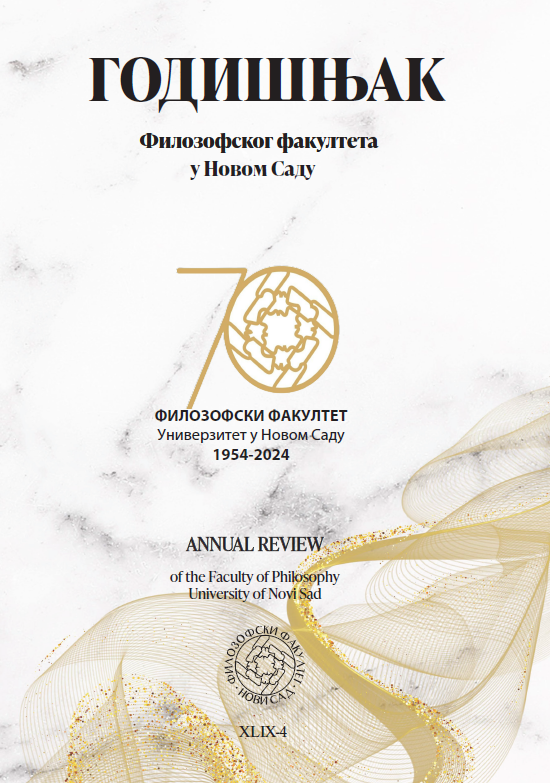THE VERIST VERGA IN CONTEMPORARY MUSIC
Main Article Content
Abstract
Our work aims to integrate the interpretative horizon, widely consolidated in the reading of Verga’s literary production —focused on capturing the philosophical, philological-linguistic, stylistic, and comparative components—through a new perspective that analyzes the adaptations and rewritings of the Catanian author’s verist works with a dual purpose: to implement a critical methodology aimed at enhancing the interdisciplinarity of the human sciences and to highlight the verist Verga’s innovative experimentalism through the transpositions of his work into contemporary culture. In the intricate landscape of interpretative misadventures related to the most prominent representative of Verismo, there is an attenuation of critical debate on the Catanian writer with ethical-civic implications, along with a decline of his influence on contemporary literature, starting from the late 1970s. However, that phase seems to correspond to a progressive widening of cultural interest in Verga’s verist narrative, with transpositions of his works into different expressive forms between the late twentieth century and the new millennium. In relation to the aforementioned period, therefore, some reinterpretations of the writer’s production are examined, without claiming to be exhaustive, in the musical domain. These re-readings, with their plurality of forms, attest to a substantial valorization not only of Verga’s verist works but also of their underlying experimentalism, emphasized especially by recent critical insights and captured through the most effective transpositions. Alongside performances of theatre, music and dance, which often propose contaminations between different music genres, the songs inspired by Verga’s verist narrative range from the novel I Malavoglia to novellas. Revisitation of Verga’s works in contemporary music reveals selective attention to specific texts and a still-limited diffusion mainly within national boundaries, with the exception of Mediterranean Voices. The best musical performances reflect the verist writer’s expressive innovation, capable of exploring ever-relevant themes and giving voice to complex human relationships. But above all, by skillfully integrating the concept of realism with Verga’s experimental approach, they stimulate the audience to critical reflection, to that interpretative effort that the Etnean writer intended to provoke through the verist method.
Downloads
Metrics
No metrics found.
Article Details

This work is licensed under a Creative Commons Attribution-ShareAlike 4.0 International License.
References
Alfieri, G. (1980). Innesti fraseologici del siciliano nei Malavoglia. Bollettino del Centro di Studi Filologici e Linguistici Siciliani, 14 (1980), 221–295.
Alfieri, G. (2016). Verga. Roma: Salerno editrice. Alfieri, G. – Riccardi, C. (2020). Scrittura «lenticolare» e stile reticolare: cosa rivela l’Edizione Nazionale di Giovanni Verga. Oblio, X(40), 14–30. https://www.progettoblio.com/archivio/oblio-x-40/ Anastasio, M. (2015, 24 March). Rosso Malpelo. YouTube. https://youtu.be/lA2ws6fvlI0 Asor Rosa, A. (ed.) (1972). Il caso Verga. Palermo: Palumbo.
Baldi, G. (1980). L’artificio della regressione. Tecnica narrativa e ideologia nel Verga verista. Napoli: Liguori.
Battiato, L. (2013, 26 July). Mena tra melodia pop e lirica. Globus magazine. https://www.globusmagazine.it/
Cadioli, A. (1998). La ricezione. Roma–Bari: Laterza.
Caparezza (2006). Ninna nanna di Mazzarò.
YouTube . https://g.co/kgs/Mm6uB3
Caturegli, A. F. (1982). Tradu
ttori del Verga in lingua inglese. Italianistica: Rivista
di Letteratura Italiana , 1 , 35 47.
Ceronetti, G. (1982). La vita apparente. Milano: Adelphi.
De Simone, V. (1948) La lupa. In Berretti, A. (2013), Libretti di opere siciliane. Altervista. 1–9. http://librettisiciliani.altervista.org/wpcontent/uploads/2019/03/LupaDeSimoneSantonocito-1.pdf
De Vito, A. J. (1941). The struggle for existence in the work of Giovanni Verga. Italica, XVII. 179–185. DOI: https://doi.org/10.2307/476186
Farinotti, P. (2023). Dizionario di tutti i film. Milano: Booktime.
Ferro, G.
Miano, M. (2015, 17 No vember). La Lupa. Note. Teatro Quirino
Gassman . https://www.teatroquirino.it/eventi/la lupa 2015 11 17/
Garozzo, F. (2010, 31 January). I Malavoglia. YouTube. https://youtu.be/n8a5-VEbwss
Luperini, R. (1976). Verga e le strutture narrative del realismo. Saggio su “Rosso Malpelo”. Padova: Liviana.
Luperini, R. (2005). Verga moderno. Bari: Laterza.
Mazzone, A. (2004).
La roba, i galantuomini, gl’innamorati . Mazzone, G. &
Mazzone, G. ( eds.). Catania: Prova d’Autore
Mazzone, G. (2015, 3 September). L’avvicinamento, YouTube. https://youtu.be/uv_NbGopr3Q
Nocetti, G. (2016, 17 November). I Malavoglia. YouTube. https://youtu.be/s0N4CB6nKL8
Ojetti, U. (1985). Alla scoperta dei letterati. Milano: Dumolard. https://books.google.it/books/about/Alla_scoperta_dei_letterati.html?id=l11_nQEACAAJ&redir_esc=y
Oliva, G. (2007). Capuana, Verga e il progetto teatrale verista. Il teatro verista, tomo I. 27- 39.
Oliva, S. (2013). Opera popolare. In Gregory, T. (ed.). Lessico del XXI secolo, Appendice VIII, vol. II. Roma: Istituto dell’Enciclopedia Italiana.
Parenti, P. (2022). “Cavalleria rusticana” Tribolazioni d’autore: Vicende di riscritture della novella verghiana tra letteratura e altre arti. Testo e Senso, 24, 143-51. doi:10.58015/2036-2293/587
Quaresima, L. (1988). La scure, il rogo (e il fucile): “La Lupa”, da Verga a Lattuada. Annali d’Italianistica, 6, 123–147. http://www.jstor.org/stable/24004194
Riccardi, C. (1984). Introduzione a G. Verga. In Verga, G. (1984). Tutte le novelle. Riccardi, C. (ed.). Milano: Mondadori, V-LXVI.
Tellini, G. (2022). Verga e il Novecento. In: Forni, G. (ed.) (2022). Verga e il verismo. Roma: Carocci. 277–289.
Venturini, M. (2006, 20 April). Un calabrese nella Big Apple. Chi è di scena [RaiTre]. Roma: Archivio Rai.
Verga, G. (1881). Vita dei campi. Milano: Treves.
https://archive.org/details/VitaDeiCampi/page/n7/mode/2up
Verga, G. (1883). Novelle rusticane. Torino: Casanova. https://it.wikisource.org/wiki/Novelle_rusticane
Verga, G. (1979). Lettere sparse. Finocchiaro-Chimirri, G. (ed.). Parma: Bulzoni.
Verga, G. (1982). The She-Wolf and Other Stories. Translated with an introduction by Giovanni Cecchetti. Berkeley-Los Angeles-London: University of California Press.
Verga, G. (1984). CarteggioVerga-Capuana. Raya, G. (ed.). Roma: Edizioni dell’Ateneo.
Verga, G. (2004). Carteggio Verga-Rod. Longo, G. (ed.). Catania: Fondazione Verga.
De Blasi, M. (2016). Verga a scuola, tra grammatiche e antologie. Italiano LinguaDue, 1, 403–413.




